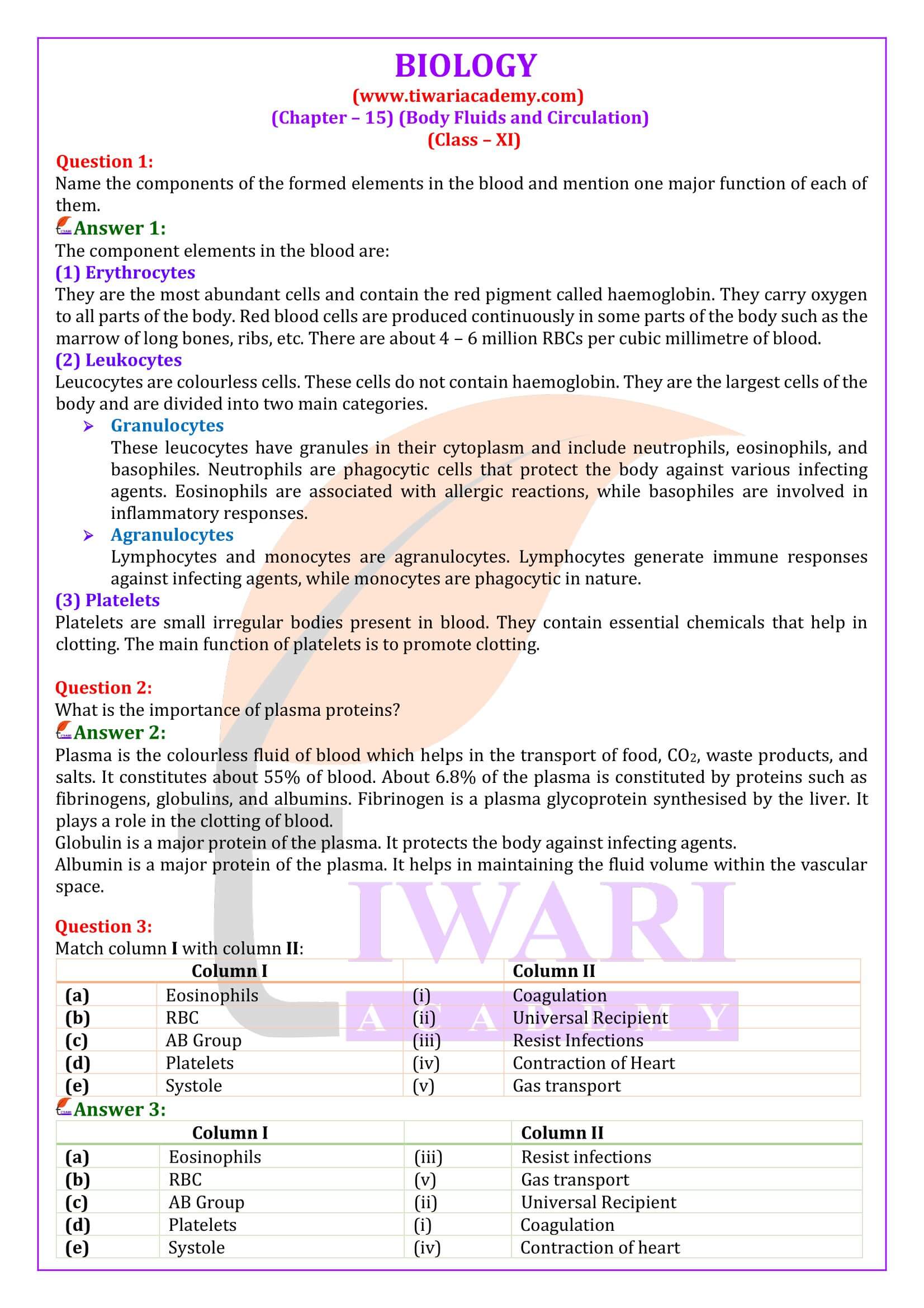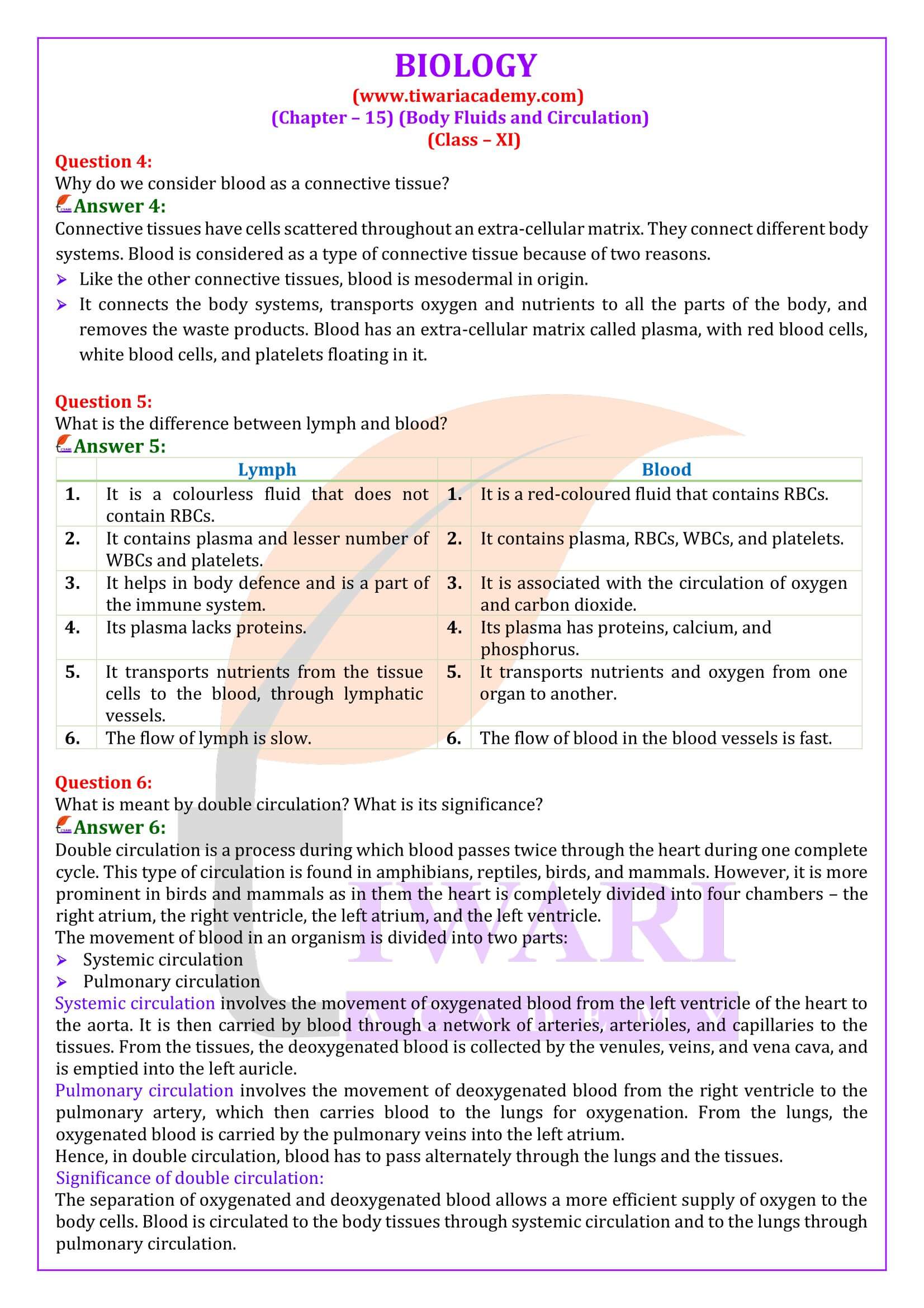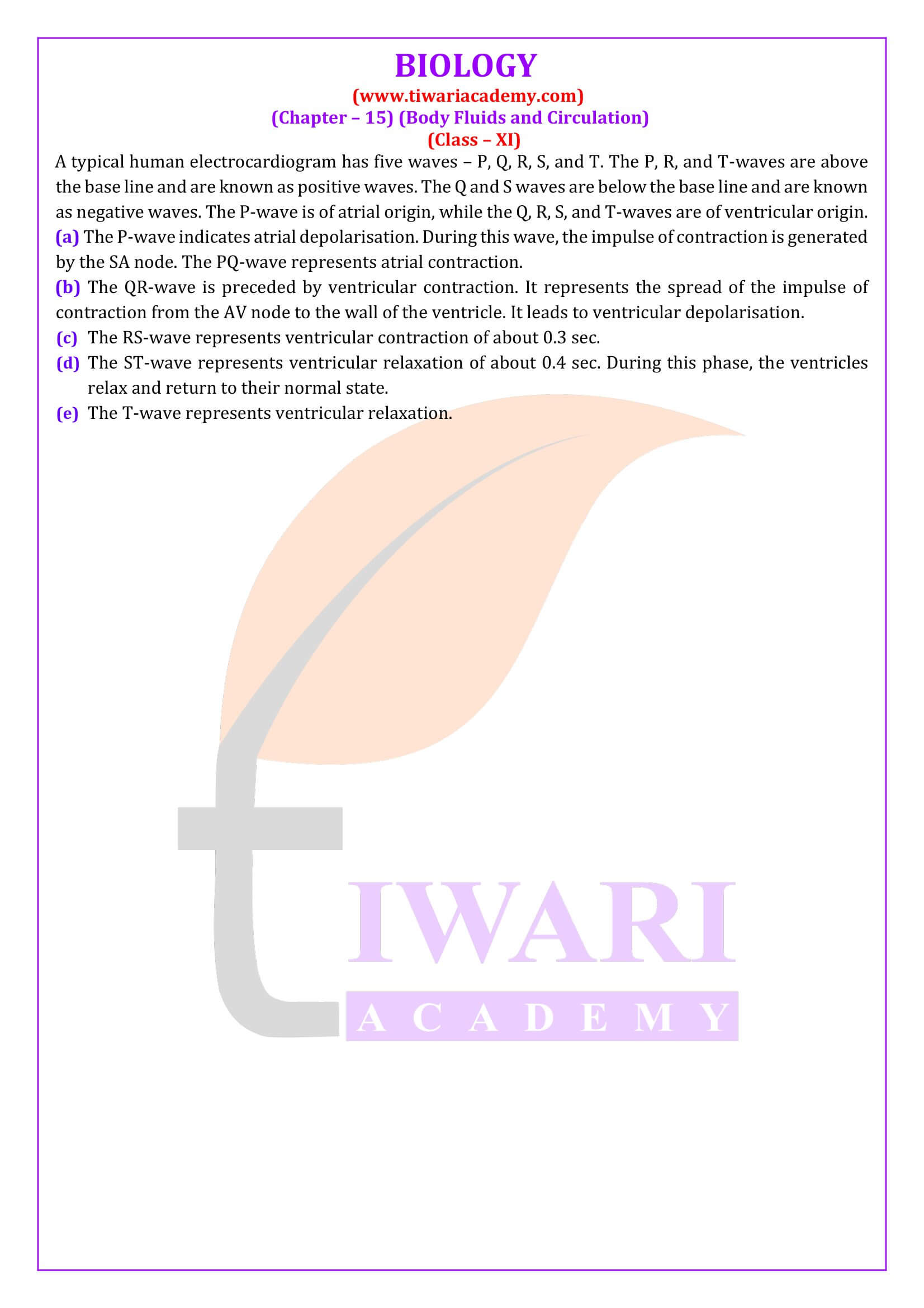NCERT Solutions for Class 11 Biology Chapter 15 Body Fluids and Circulation in Hindi and English Medium PDF format to Free Download the files for academic session 2024-25. Download NCERT Solutions for other subjects for UP Board, MP Board, CBSE and other boards also using using NCERT Books. Visit to Discussion Forum and join the world of knowledge.
NCERT Solutions for Class 11 Biology Chapter 15
Class 11 Biology Chapter 15 Body Fluids and Circulation Solutions
| Class: 11 | Biology |
| Chapter 15: | Body Fluids and Circulation |
| Content: | Exercises Answers and Extra Questions |
| Mode of Content: | Text, Videos, PDF and Images |
| Academic Session: | Year 2024-25 |
| Medium available: | Hindi and English |
Class 11 Biology Chapter 15 Solutions in English
NCERT Solutions for Class 11 Biology Chapter 15 in PDF format to free download is given below. Download NCERT Books 2024-25 for new academic session following the latest CBSE Syllabus. Offline Apps and NCERT Solutions are helpful for NIOS students also. Explore the your knowledge through discussion forum and help the other students replying their questions.
Important Notes on Body Fluids and Circulation
1. Cardiac output: The amount of blood pumped by heart per minute is called cardiac or heart output. The value of cardiac output of a normal person is about 72 × 70 = 5040 mL or about 5L per minutes.
2. Electrocardiograph (ECG): The machine used to record electrocardiogram.
3. Electrocardiogram ECG: The graphic record of the electric current produced by the excitation of the cardiac muscles. It is composed of a ‘P’ wave, ‘QRS’ wave. (Complex) and ‘T’ wave.
BLOOD
1. A special connective tissue that circulates in principal vascular system of man and other vertebrates consisting of fluid matrix, plasma and formed elements.
2. Blood Pressure: The resistance offered by the lumen of the artery to the flow of Blood.
Cardiac Cycle: The rhythmic contraction and dilation of different parts of heart in one beat.
3. Hypertension: The condition when blood pressure is higher than normal (120/80 mmHg)
4. Systole: Contraction of heart muscles.
5. Diastole: Relaxation of heart muscles.
PLASMA
1. The liquid part of blood or lymph which is straw coloured, viscous fluid and contains (only lymbphocytes) about 90-92% of water and 6-8% proteins.
2. Lymph: A clear yellowish, slightly alkaline, coagulable fluid, containing white blood cells in a liquid resembling blood plasma.
3. Serum: Blood plasma from which fibrinogen and other clotting factors have been removed.
4. Heart Beat: The rhythmic contraction and relaxation of the heart, which includes one systole (contraction phase) and one diastole (relaxation phase) of the heart. Heart beat count of healthy person is 72 times per minute.
Important Questions on 11th Biology Chapter 15
Name the components of the formed elements in the blood and mention one major function of each of them.
The component elements in the blood are: (1) Erythrocytes They are the most abundant cells and contain the red pigment called haemoglobin. They carry oxygen to all parts of the body. Red blood cells are produced continuously in some parts of the body such as the marrow of long bones, ribs, etc. There are about 4 – 6 million RBCs per cubic millimetre of blood. (2) Leukocytes Leucocytes are colourless cells. These cells do not contain haemoglobin. They are the largest cells of the body and are divided into two main categories. Granulocytes These leucocytes have granules in their cytoplasm and include neutrophils, eosinophils, and basophiles. Neutrophils are phagocytic cells that protect the body against various infecting agents. Eosinophils are associated with allergic reactions, while basophiles are involved in inflammatory responses. Agranulocytes Lymphocytes and monocytes are agranulocytes. Lymphocytes generate immune responses against infecting agents, while monocytes are phagocytic in nature. (3) Platelets Platelets are small irregular bodies present in blood. They contain essential chemicals that help in clotting. The main function of platelets is to promote clotting.
What is the importance of plasma proteins?
Plasma is the colourless fluid of blood which helps in the transport of food, CO2, waste products, and salts. It constitutes about 55% of blood. About 6.8% of the plasma is constituted by proteins such as fibrinogens, globulins, and albumins. Fibrinogen is a plasma glycoprotein synthesised by the liver. It plays a role in the clotting of blood. Globulin is a major protein of the plasma. It protects the body against infecting agents. Albumin is a major protein of the plasma. It helps in maintaining the fluid volume within the vascular space.
Why do we consider blood as a connective tissue?
Connective tissues have cells scattered throughout an extra-cellular matrix. They connect different body systems. Blood is considered as a type of connective tissue because of two reasons. Like the other connective tissues, blood is mesodermal in origin. It connects the body systems, transports oxygen and nutrients to all the parts of the body, and removes the waste products. Blood has an extra-cellular matrix called plasma, with red blood cells, white blood cells, and platelets floating in it.
What is meant by double circulation? What is its significance?
Double circulation is a process during which blood passes twice through the heart during one complete cycle. This type of circulation is found in amphibians, reptiles, birds, and mammals. However, it is more prominent in birds and mammals as in them the heart is completely divided into four chambers – the right atrium, the right ventricle, the left atrium, and the left ventricle. The movement of blood in an organism is divided into two parts: Systemic circulation Pulmonary circulation Systemic circulation involves the movement of oxygenated blood from the left ventricle of the heart to the aorta. It is then carried by blood through a network of arteries, arterioles, and capillaries to the tissues. From the tissues, the deoxygenated blood is collected by the venules, veins, and vena cava, and is emptied into the left auricle. Pulmonary circulation involves the movement of deoxygenated blood from the right ventricle to the pulmonary artery, which then carries blood to the lungs for oxygenation. From the lungs, the oxygenated blood is carried by the pulmonary veins into the left atrium. Hence, in double circulation, blood has to pass alternately through the lungs and the tissues. Significance of double circulation: The separation of oxygenated and deoxygenated blood allows a more efficient supply of oxygen to the body cells. Blood is circulated to the body tissues through systemic circulation and to the lungs through pulmonary circulation.
Why do we call our heart myogenic?
In the human heart, contraction is initiated by a special modified heart muscle known as sinoatrial node. It is located in the right atrium. The SA node has the inherent power of generating a wave of contraction and controlling the heartbeat. Hence, it is known as the pacemaker. Since the heart beat is initiated by the SA node and the impulse of contraction originates in the heart itself, the human heart is termed myogenic. The hearts of vertebrates and molluscs are also myogenic.
Sino-atrial node is called the pacemaker of our heart. Why?
The sino-atrial (SA) node is a specialised bundle of neurons located in the upper part of the right atrium of the heart. The cardiac impulse originating from the SA node triggers a sequence of electrical events in the heart, thereby controlling the sequence of muscle contraction that pumps blood out of the heart. Since the SA node initiates and maintains the rhythmicity of the heart, it is known as the natural pacemaker of the human body.
What is the significance of atrio-ventricular node and atrio-ventricular bundle in the functioning of heart?
The atrioventricular (AV) node is present in the right atrium, near the base of the inter-auricular septum that separates the right auricle from the ventricle. It gives rise to the bundle of His that conducts the cardiac impulses from the auricles to the ventricles. As the bundle of His passes the ventricle along the inter-ventricular septum, it divides into two branches – the right ventricle and the left ventricle. The end branches of this conducting system then forms a network of Purkinje fibres that penetrate into the myocardium. The auricular contraction initiated by the wave of excitation from the sino-atrial node (SA node) stimulates the atrio-ventricular node, thereby leading to the contraction of ventricles through the bundle of His and Purkinje fibres. Hence, the atrio-ventricular node and the atrioventricular bundle play a role in the contraction of ventricles.
Define a cardiac cycle and the cardiac output.
Cardiac cycle is defined as the complete cycle of events in the heart from the beginning of one heart beat to the beginning of the next. It comprises three stages – atrial systole, ventricular systole, and complete cardiac diastole. Cardiac output is defined as the amount of blood pumped out by the ventricles in a minute.
Explain heart sounds.
Heart sounds are noises generated by the closing and opening of the heart valves. In a healthy individual, there are two normal heart sounds called lub and dub. Lub is the first heart sound. It is associated with the closure of the tricuspid and bicuspid valves at the beginning of systole. The second heart sound dub is associated with the closure of the semilunar valves at the beginning of diastole. These sounds provide important information about the condition and working of the heart.
Lymph
1. The colourless mobile fluid connective tissue drains into the lymphatic capillaries from the intercellular spaces. It is formed by squeezing of blood through capillaries, within tissues. Its ¯ow is unidirectional i.e., from tissues to heart.
Composition:
2. It is composed of fluid matrix, plasma, white blood corpuscles or leucocytes.
3. Functions:
i). It drains excess tissue from extra cellular spaces back into the blood,
ii). It contain lymphocytes and antibodies.
iii). It transport digested fats.










